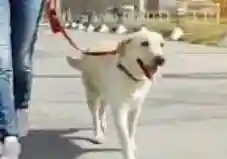Hello Everybody! Do you ever face when you walk with your dog and all of a sudden your dog stops walking and it won’t move at all? Walking your dog is not only beneficial for their physical health but also a wonderful bonding experience. However, when your dog suddenly stops walking and won’t move, it can be concerning and frustrating. In this comprehensive guide, we’ll explore the possible reasons behind this dog’s behavior, and provide practical solutions. We offer expert advice to ensure both you and your four-legged companion can enjoy walks without any hiccups.
Dog Stops Walking and Won’t Move: Understanding the Problem
The first step in addressing this issue is to understand why your dog stops walking suddenly. Let’s delve into some common causes:
- Physical Discomfort: Dogs may experience pain or discomfort that causes them to stop walking. It could be due to an injury, joint issues, or even a foreign object stuck in their paw. Always check for physical discomfort first.
- Fear and Anxiety: Loud noises, unfamiliar surroundings, or encountering aggressive dogs can trigger fear or anxiety in your dog, leading them to halt and refuse to move.
- Medical Conditions: Certain medical conditions, such as arthritis, can make walking uncomfortable for your dog. It’s essential to rule out any underlying health issues.
- Training or Behavioral Issues: Inconsistent training, lack of socialization, or negative past experiences can affect your dog’s behavior during walks.
- Temperature Sensitivity: Extreme weather conditions, especially heat, can make walking uncomfortable for dogs, causing them to stop and seek relief.
- Age and Energy Level: Older dogs or dogs with lower energy levels might need shorter walks, and pushing them too much can result in them stopping abruptly.
Solutions to Encourage Your Dog to Keep Walking
Now that we’ve identified potential causes, let’s explore solutions to help your dog overcome this behavior and enjoy walks again:

- Regular Vet Check-ups: Ensure your dog’s health is in check by scheduling regular visits to the vet. Address any underlying medical issues promptly.
- Positive Reinforcement: Encourage your dog with treats, praise, and toys. Reward them for taking steps and moving forward during walks.
- Gradual Desensitization: If your dog is fearful or anxious, gradually expose them to the triggers in a controlled environment. Over time, they’ll become more comfortable.
- Proper Training: Invest time in training your dog with basic commands like “heel” and “come.” A well-trained dog is more likely to walk without stopping.
- Suitable Walking Conditions: Choose appropriate times for walks to avoid extreme weather. Early mornings or late evenings during hot days can be more comfortable for your dog.
- Age-Appropriate Activities: Adjust the duration and intensity of walks based on your dog’s age and energy level. Be mindful of their limitations.
Expert Advice for a Happy Dog Walking Experience
To gain more insights into this issue, we reached out to renowned dog trainer and behaviorist, Dr. Julie Davis, for her expert advice:
“When a dog stops walking and won’t move, it’s crucial to remain patient and calm. Understand the potential triggers, whether it’s physical discomfort or anxiety, and work on addressing them. Consistent training, positive reinforcement, and gradual exposure to challenging situations can make a significant difference. Always prioritize your dog’s comfort and well-being during walks.”
Additional Guidance for Encouraging Your Dog’s Walks
- Buddy System: When dealing with young puppies, consider enlisting the assistance of a more confident canine companion. Have a helper take your puppy for a walk while you lead another pup ahead. Shower the confident pup with praise, pets, and treats, making a big fuss over their cooperation. Your puppy might be inspired to join in on the excitement. Offer praise and rewards when your puppy decides to participate.
- Treats for Movement: Use treats strategically to motivate your dog to move. Display a delectable treat, and as soon as your dog takes a step forward, offer praise and hand over the treat.
- Exclusive Outdoor Treats: Make sure the treats you provide are reserved solely for outdoor adventures. This reinforces the idea that going outside is a special and enjoyable experience for your dog.
- Social Interaction: If your dog enjoys meeting people, arrange for them to step away a bit and call your dog over. This encourages your dog to walk over to greet them, adding an element of excitement to the walk.
- Extended Leash Walks: In areas with no traffic or safety concerns, try using a long-line leash (often available in horse tack stores or online). Begin walking at a distance from your dog. Gradually, your dog may start following you, feeling the need to reconnect. Remember to reward and praise your dog when they reach you.
- Familiar Surroundings: Drive your dog close to your home, park the car, and walk the rest of the way with your furry friend. This approach can help your dog regain confidence in the safety of the neighborhood. Bring along treats to create positive associations and convince your dog that the area is an excellent place for a stroll. You may need to repeat this process a few times until your dog becomes more comfortable with the routine.
- Calming Aids: Consider using calming aids if necessary. Options like DAP collars, calming supplements such as Composure, anxiety wraps, and Thundershirts can help ease your dog’s anxiety and stress during walks.
- Vet Consultation: In persistent cases, consult with your veterinarian. They may recommend a mild tranquilizer to help your dog gradually become accustomed to the idea that neighborhood walks are safe and enjoyable again.
Conclusion
Dog stops walking and refuses to move can be a challenging situation, but with the right understanding, training, and care, you can help your furry friend overcome this issue. Remember to prioritize their comfort, health, and happiness during walks. By implementing the solutions and expert advice provided in this guide, you’ll be on the path to enjoyable walks together once again. We believe you enjoyed this article. Happy Daily Dog walking!
Frequently Asked Questions (FAQs)
Why does my dog suddenly stop walking during our daily walks?
There could be various reasons, such as physical discomfort, fear, medical conditions, or training issues. Identifying the specific cause is essential for finding a solution.
My dog is a senior. Could age be a factor in them stopping during walks?
Yes, age and energy level play a role. Older dogs or dogs with lower energy may need shorter, more leisurely walks. Adjust the walk duration to suit their needs.
Should I force my dog to keep walking when they stop?
It’s essential to assess the situation carefully. If your dog is experiencing discomfort or fear, forcing them to walk can worsen the issue. Address the underlying cause instead.
Can I use treats to encourage my dog to keep walking?
Absolutely! Positive reinforcement with treats, praise, and toys can be very effective in motivating your dog to continue walking.
Are certain breeds more prone to this behavior?
While any dog can exhibit this behavior, some breeds may be more sensitive or prone to anxiety. Understanding your dog’s breed tendencies can help address the issue.
How can I prevent my dog from stopping during walks?
Proper training, regular vet check-ups, appropriate walking conditions, and understanding your dog’s individual needs are key to preventing this behavior.
“The information presented in this article is believed to be accurate and reliable, based on the author’s knowledge and research. However, it is essential to note that this content is intended for informational purposes only and should not be considered a replacement for personalized guidance from a qualified professional. For specific advice regarding the care, health, or well-being of your small crossbreed dog, it is recommended to consult with a certified veterinarian or pet care expert.”







Leave a Comment
You must be logged in to post a comment.